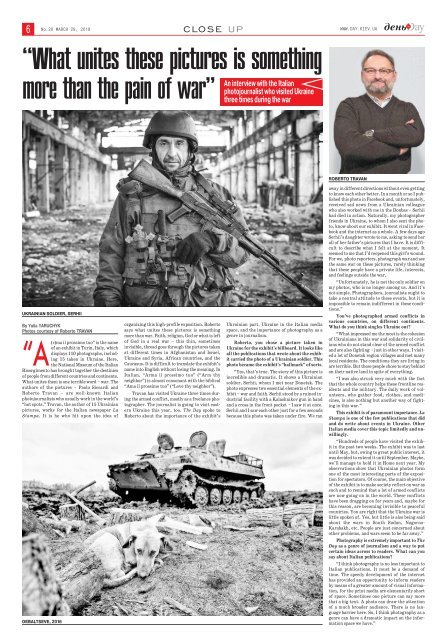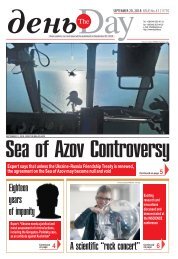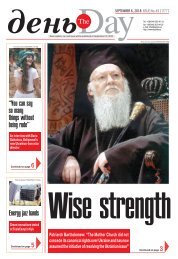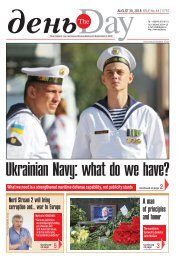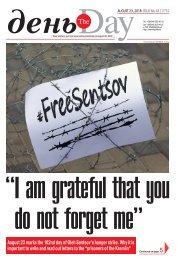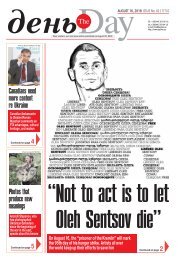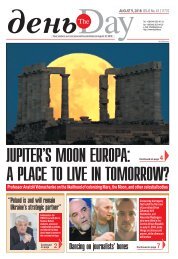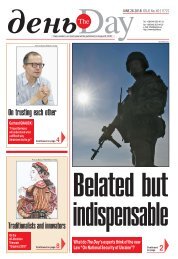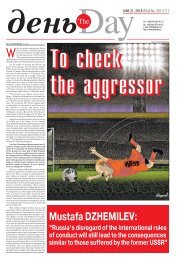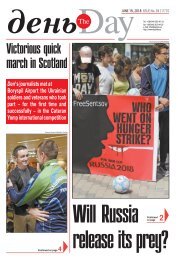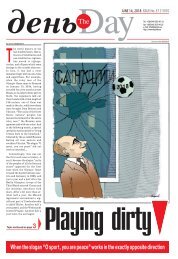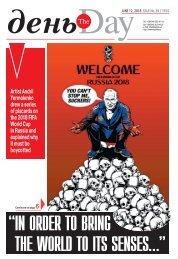You also want an ePaper? Increase the reach of your titles
YUMPU automatically turns print PDFs into web optimized ePapers that Google loves.
6<br />
No.20 MARCH 29, 2018<br />
CLOSE UP<br />
WWW.DAY.KIEV.UA<br />
“What unites these pictures is something<br />
more than the pain of war”<br />
An interview with the Italian<br />
photojournalist who visited Ukraine<br />
three times during the war<br />
ROBERTO TRAVAN<br />
UKRAINIAN SOLDIER, SERHII<br />
By Yulia YARUCHYK<br />
Photos courtesy of Roberto TRAVAN<br />
il prossimo tuo” is the name<br />
of an exhibit in Turin, Italy, which<br />
displays 110 photographs, including<br />
15 taken in Ukraine. Here,<br />
“A(r)ma<br />
the National Museum of the Italian<br />
Risorgimento has brought together the destinies<br />
of people from different countries and continents.<br />
What unites them is one terrible word – war. The<br />
authors of the pictures – Paolo Siccardi and<br />
Roberto Travan – are well-known Italian<br />
photojournalists who usually work in the world’s<br />
“hot spots.” Travan, the author of 15 Ukrainian<br />
pictures, works for the Italian newspaper La<br />
Stampa. It is he who hit upon the idea of<br />
DEBALTSEVE, 2016<br />
organizing this high-profile exposition. Roberto<br />
says what unites these pictures is something<br />
more than war. Faith, religion, God or what is left<br />
of God in a real war – this thin, sometimes<br />
invisible, thread goes through the pictures taken<br />
at different times in Afghanistan and Israel,<br />
Ukraine and Syria, African countries, and the<br />
Caucasus. It is difficult to translate the exhibit’s<br />
name into English without losing the meaning. In<br />
Italian, “Arma il prossimo tuo” (“Arm thy<br />
neighbor”) is almost consonant with the biblical<br />
“Ama il prossimo tuo” (“Love thy neighbor”).<br />
Travan has visited Ukraine three times during<br />
the armed conflict, mostly as a freelance photographer.<br />
The journalist is going to visit eastern<br />
Ukraine this year, too. The Day spoke to<br />
Roberto about the importance of the exhibit’s<br />
Ukrainian part, Ukraine in the Italian media<br />
space, and the importance of photography as a<br />
genre in journalism.<br />
Roberto, you chose a picture taken in<br />
Ukraine for the exhibit’s billboard. It looks like<br />
all the publications that wrote about the exhibit<br />
carried the photo of a Ukrainian soldier. This<br />
photo became the exhibit’s “hallmark” of sorts.<br />
“Yes, that’s true. The story of this picture is<br />
incredible and dramatic. It shows a Ukrainian<br />
soldier, Serhii, whom I met near Donetsk. The<br />
photo expresses two essential elements of the exhibit<br />
– war and faith. Serhii stood by a ruined industrial<br />
facility with a Kalashnikov gun in hand<br />
and a cross in the front pocket – I saw it at once.<br />
Serhii and I saw each other just for a few seconds<br />
because this photo was taken under fire. We ran<br />
away in different directions without even getting<br />
to know each other better. In a month or so I published<br />
this photo in Facebook and, unfortunately,<br />
received sad news from a Ukrainian colleague<br />
who also worked with me in the Donbas – Serhii<br />
had died in action. Naturally, my photographer<br />
friends in Ukraine, to whom I also sent the photo,<br />
know about our exhibit. It went viral in Facebook<br />
and the internet as a whole. A few days ago<br />
Serhii’s daughter wrote to me, asking to send her<br />
all of her father’s pictures that I have. It is difficult<br />
to describe what I felt at the moment. It<br />
seemed to me that I’d reopened this girl’s wound.<br />
For we, photo reporters, photograph war and see<br />
the same war on these pictures, rarely thinking<br />
that these people have a private life, interests,<br />
and feelings outside the war.<br />
“Unfortunately, he is not the only soldier on<br />
my photos, who is no longer among us. And it’s<br />
not simple. Photographers, journalists ought to<br />
take a neutral attitude to these events, but it is<br />
impossible to remain indifferent in these conditions.”<br />
You’ve photographed armed conflicts in<br />
various countries, on different continents.<br />
What do you think singles Ukraine out?<br />
“What impressed me the most is the cohesion<br />
of Ukrainians in this war and solidarity of civilians<br />
who do not stand clear of the armed conflict<br />
and are also fighting – just in other ways. I visited<br />
a lot of Donetsk region villages and met many<br />
local residents. The conditions they are living in<br />
are terrible. But these people chose to stay behind<br />
on their native land in spite of everything.<br />
“I was also struck very much with the fact<br />
that the whole country helps these frontline residents<br />
and the military. The daily work of volunteers,<br />
who gather food, clothes, and medicines,<br />
is also nothing but another way of fighting<br />
in this war.”<br />
This exhibit is of paramount importance. La<br />
Stampa is one of the few publications that did<br />
and do write about events in Ukraine. Other<br />
Italian media cover this topic limitedly and unwillingly.<br />
“Hundreds of people have visited the exhibit<br />
in the past two weeks. The exhibit was to last<br />
until May, but, owing to great public interest, it<br />
was decided to extend it until September. Maybe,<br />
we’ll manage to hold it in Rome next year. My<br />
observations show that Ukrainian photos form<br />
one of the most interesting parts of the exposition<br />
for spectators. Of course, the main objective<br />
of the exhibit is to make society reflect on war as<br />
such and to remind that a lot of armed conflicts<br />
are now going on in the world. These conflicts<br />
have been dragging on for years and, maybe for<br />
this reason, are becoming invisible to peaceful<br />
countries. You are right that the Ukraine war is<br />
little spoken of. Yes, but little is also being said<br />
about the wars in South Sudan, Nagorno-<br />
Karabakh, etc. People are just concerned about<br />
other problems, and wars seem to be far away.”<br />
Photography is extremely important to The<br />
Day as a genre of journalism and a way to put<br />
certain ideas across to readers. What can you<br />
say about Italian publications?<br />
“I think photography is no less important to<br />
Italian publications. It must be a demand of<br />
time. The speedy development of the internet<br />
has provided an opportunity to inform readers<br />
by means of a greater amount of visual information,<br />
for the print media are elementarily short<br />
of space. Sometimes one picture can say more<br />
that a big text. A photo can draw the attention<br />
of a much broader audience. There is no language<br />
barrier here. So, I think photography as a<br />
genre can have a dramatic impact on the information<br />
space we have.”


